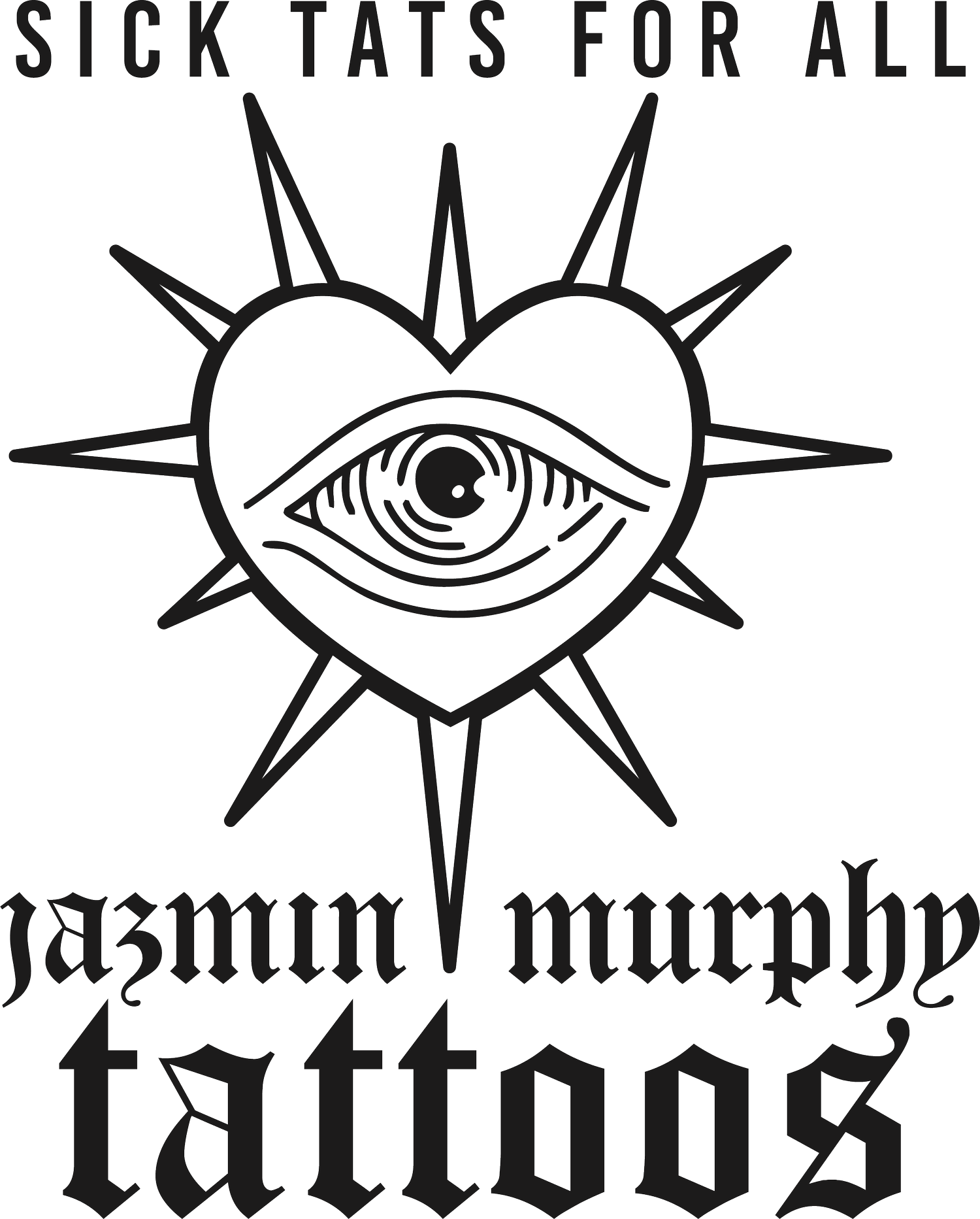Aftercare
-
Second Skin Bandages
For clients who are not allergic to acrylic or adhesives.
Leave your bandage on for about 3 days.
Remove your bandage carefully and slowly under warm running water.
Gently wash your tattoo with antibacterial soap.
Apply a thin layer of tattoo approved moisturizer.
Discard used bandage.
Repeat steps 3 and 4 daily, until your tattoo is no longer an open wound (7-10 days)
Additional Notes:
Second skin bandages may collect body fluids and excess ink that weep from your tattoo; this is normal.
Minor peeling at the edge of your bandage may occur, and is normal.
Please remove and discard your bandage if your tattoo becomes exposed.Second skin bandages are water resistant, and can usually withstand gentle showering and light sweating.
Some minor redness may be present after removal, due to tugging on the skin.
Adhesive residue can be easily removed with any body safe oil.
SIGNS OF AN ADHESIVE ALLERGY INCLUDE:
Blisters
intensely itchy skin
flaking skin
a rash
If you suspect an adhesive allergy:
Remove your bandage immediately.
Wash the area with soap and water, and be sure to remove any adhesive residue.
Continue to wash and lotion your tattoo as normal (see steps under “traditional bandages”)
Discontinue use of adhesives. Contact a medical professional if necessary.
-
Traditional Bandages
For clients who are allergic to, or prefer not to use a second skin bandage.
Traditional bandages include a layer of ointment, covered with a non-adhesive dressing.
Remove and discard your bandage at home before bed.
Wash gently with antibacterial soap.
Dry with a clean paper towel.
Apply a thin layer of water based lotion.
Cover with loose, clean clothing when out, while interacting with children or pets, or while sleeping.
-
Use a mild, unscented, antibacterial soap to clean your tattoo about 1-3 times per day.
I recommend liquid Dial Gold Antibacterial soap
Things to avoid:
Harsh medical-grade or surgical soaps.
Soap with scents, essential oils, or alcohol. These can irritate, dry out, or cause a burning sensation on your new tattoo.
Bars of soap that may collect bacteria or debris. Opt for a clean bottle of liquid soap instead.
Rags, loofas, or other abrasive materials. Only use clean hands to wash your tattoo.
-
Apply a thin layer of tattoo approved lotion 1-3 times/ day, with CLEAN hands.
Tattoo approved lotions are:
white in color
water-based
fragrance-free
aloe-free
healing variety or tattoo specific branding
Brands I recommend:
Hustle Butter Deluxe
After Inked Lotion
Recovery Healing Salve
Drugstore brands: Nivea, Eucerin, CeraVe, Generic brand healing lotion
Things to Avoid:
Thick or excessive layers of lotion.
This can suffocate your tattoo, or lead to bacterial growth if your skin is too wet too often.
products with alcohol, petroleum, lanolin, mineral oil (such as vitamin A or D), parabens, phthalates, or fragrances.
These ingredients can lead to irritation or suffocation of your new tattoo.
-
Touching your new tattoo
Itching, slapping, or picking at your new tattoo.
Tight elastic clothing, jewelry, or rubber bands. This pressure can ”rub out” or lighten areas of the tattoo.
Alcohol, petroleum, lanolin, mineral oil (such as vitamin A or D), parabens, phthalates, or fragrances.
Wash cloths, loofahs or other abrasive items.. These items can be irritating or harbor bacteria.
Bodies of water, including baths, hot tubs, pools, lakes, oceans, etc.
Sun exposure or tanning beds for the lifetime of your tattoo. Regularly apply sunscreen to your healed tattoo.
-
Seek professional medical attention if you suspect an infection.
Signs of infection include, but are not limited to:
Redness, swelling, or pain that suddenly appears, persists, or worsens after the initial procedure.
Your tattoo or the surrounding skin feels hot to the touch.
Pus or discharge
Signs of a fever
Hard scabs or bumps
-
How long does a tattoo take to heal?
Tattoos typically take 7-10 days to no longer be an open wound.Tattoos continue to heal under the skin or “settle” for up to 12 months.
When can I shower again?
You can continue to shower normally after receiving your tattoo.
Avoid prolonged exposure/ soaking in water.
When can I exercise again?
Avoid exercise for a few days, or while wearing a second skin bandage. Avoid touching your new tattoo to gym surfaces, and wash your tattoo after exercising.When can I go swimming again?
Avoid swimming or submerging your tattoo in water, until your tattoo is no longer an open wound.When will I need a touch up?
All tattoos will fade over a lifetime, but touch ups can help extend the life of your tattoo. Touch ups are only performed on fully healed tattoos, at the artist’s discretion.
